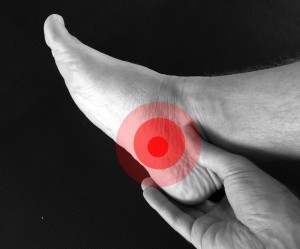31 Mar Heel Pain / Plantar Fasciitis
 10% of adults will suffer with heel pain in their lifetime (Riddle 2004), with Plantar fasciitis the most common cause of heel pain. Plantar fasciitis is a painful condition of tissue damage at the attachment of the plantar fascia to the underside of the foot. The plantar fascia is the flat band of tissue that connects your heel bone to your toes. It supports the arch of your foot. If you strain your plantar fascia it may become swollen, inflamed and irritated.
10% of adults will suffer with heel pain in their lifetime (Riddle 2004), with Plantar fasciitis the most common cause of heel pain. Plantar fasciitis is a painful condition of tissue damage at the attachment of the plantar fascia to the underside of the foot. The plantar fascia is the flat band of tissue that connects your heel bone to your toes. It supports the arch of your foot. If you strain your plantar fascia it may become swollen, inflamed and irritated.
Symptoms
Symptoms you may be experiencing:
- sharp pain felt slightly to the inside of the bottom of the heel;
- tender to press on;
- most painful first thing in the morning;
- painful standing on hard surfaces with bare feet;
- heel pain after and during prolonged exercise;
- mild swelling in the heel;
- often feels better when wearing corrective shoes/runners.
Treatment
Generally conservative treatment is the 1st approach. Plantar Fasciitis can be quite debilitating, and frustrating often taking an extended period of time to get it right. An assessment by a Podiatrist is often best to determine the initial cause, and to outline a clear evidence-based treatment plan for you going forward. Remember everybody is different, with different contributing factors, so a proper assessment is necessary for your ideal treatment plan.
In 2014, the Orthopaedic Section of the American Physical Therapy Association published updated Clinical practice guidelines (JOSPT, 2014) on the best evidence-based treatments for plantar fasciitis.
There is strong evidence for using:
-Mobilization / Massage (Manual Therapy). Treatments aimed at improving joint mobility, PF and calf flexibility are shown to decrease pain and improve function.
– Stretching. Plantar-fascia and calf muscle stretching is shown to provide short-term (1week- 4months) pain relief.
– Taping. Taping has been shown to be effective for immediate pain reduction and improved function for the short-term.
-Foot orthoses. Either prefabricated or custom fabricated orthosis (to support the medial longitudinal arch and cushion the heel) have been shown to reduce pain and improve function for the short and long-term period.
–Night splints. Beneficial for 1-3 months for individuals who consistently have pain with 1st step in the morning.
There was very weak or conflicting evidence for using electrotherapy, low-level laser, specific footwear, dry needling and ultrasound. This is not necessarily saying these treatments don’t help. It suggests that this should not be the 1st approach for management.
Recent research
In a recent study published in JOSPT (February 2017), they studied a database of 819,963 patients diagnosed with plantar fasciitis. Only 7.1% were referred to physical therapy and received evidence-based treatment (manual therapy, exercises). They found those that did receive evidence-based treatment averaged fewer treatments and a much lower cost of care- ie. They got better faster for less cost!


